The story of Samurai Jack is summarized by his nemesis, Aku, in the voiceover that precedes every episode:
Long ago in a distant land, I, Aku, the shape-shifting Master of Darkness, unleashed an unspeakable evil! But a foolish Samurai warrior wielding a magic sword stepped forth to oppose me. Before the final blow was struck, I tore open a portal in time and flung him into the future, where my evil is law! Now the fool seeks to return to the past, and undo the future that is Aku!
It is very, very difficult to convey just what makes this series so incredibly compelling. Part of the reason for this is because it transcends a single “style” of animation. The artwork is clean, simple, and direct. The action unfolds almost like a manga, with multiple panels on screen and different viewpoints; at others. At times, the landscapes are gritty and dysfunctional and crowded; at others, it’s like classical Chinese paintings, especially when Jack journeys across the wilderness. At one moment, the characters are lean and stylized, at others incredibly detailed. There are entire episodes with minimal dialouge, and almost every episode has it’s own musical score.
And yet, for all the artistic complexity, the story is refreshingly simple: Aku is evil (incarnate). Jack must destroy him, by finding a portal to return to his own time and preventing Aku’s domination of the world. As Jack journeys across the enslaved Earth, he frees groups and entire races from Aku’s tyranny, inspires hope amongst the oppressed masses, and fights off a never-ending stream of robots, monsters, bounty hunters, and mystical creatures. Throughout every trial, he adheres to his code of honor and triumphs with the (literal, as we come to see) power of righteousness.
Below the fold are some screenshots from the first episode, which covers the events of Aku’s narration.
The Masters of Masters, the Deliverer of Darkness, the Shogun of Sorrow.
In a sneak attack, Aku destroys Jack’s kingdom and enslaves his father (the emperor) and his people. Jack and his mother escape to sea, with the enchanted sword that his father first used to defeat Aku many years ago with the help of the gods. A fail-safe secret plan is thus set into motion.
Jack’s training takes him to all corners of the earth, to all the great civilizations. He learns navigation from the sea captain, and how to ride horses in Arabia. He then travels by horse across Africa to Kenya, where he trains with the fighting staff with the Masai.
From Kenya, Jack travels to Egypt for studies, then to Greece for wrestling. He also makes (somewhat silly) side trips to Britain (to study archery with Robin Hood), to Russia (axe-throwing), the Norse seas (sailing), and the Mongol steppes (spears). Ultimately he ends up in China, studying kung fu with Shaolin monks.
Finally, Jack is ready, and travels to a secret cave temple, where he reunites with his mother and receives his father’s mystic sword. Donning his samurai robes, he is truly ready to fight Aku and free his people.
Jack’s old homeland has been transformed into a wasteland where his people toil as slaves for Aku. His father, the former emperor, is chained to a great mill and is frail and weak after decades of hard labor. Suddenly, Jack bursts onto the scene and destroys the minions guarding his father.
Jack is revealed in all his noble glory. I stitched this pic together from a vertical pan, click to enlarge and appreciate the stylization.
I’ll continue the story tomorrow.
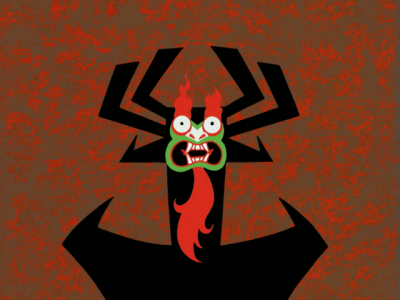
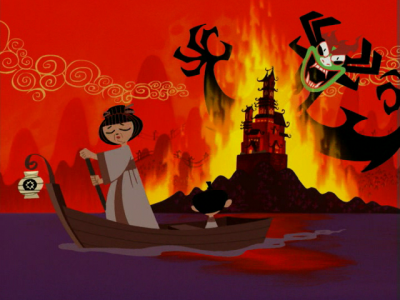
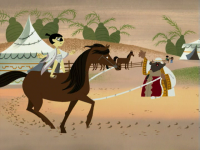
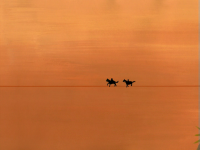
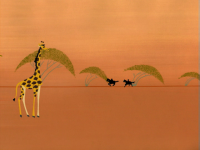
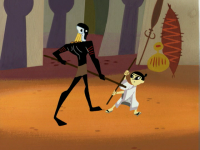
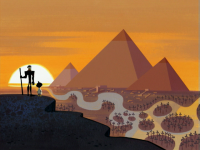
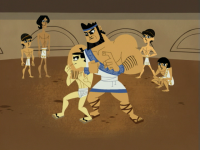
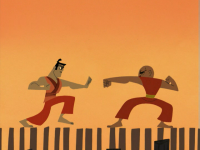
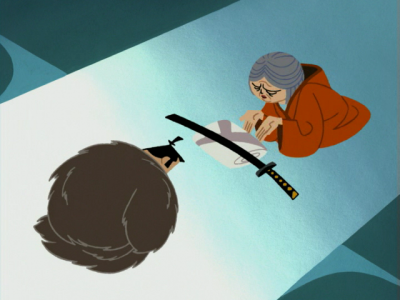
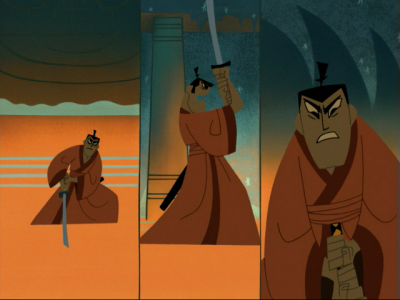
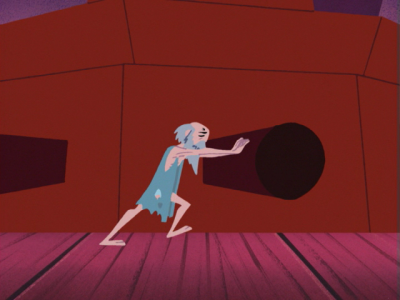
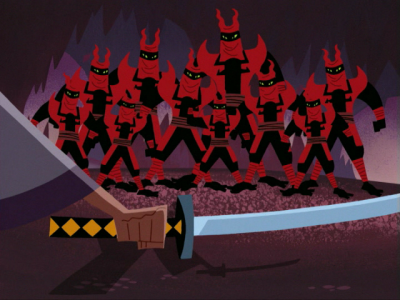
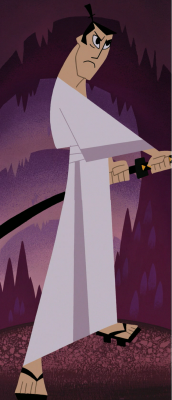
2 responses to “Samurai Jack”
One subtle thing about the art: no black lines around areas. That was a conscious choice, and it really changes the feel.
ahhh – that explains the clean look. I was wondering why it seemed so subtly different! now that you pointed this out it’s immediately obvious in hindsight. How do they do that?